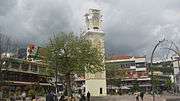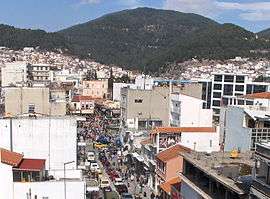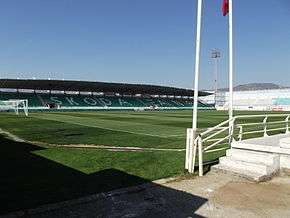Xanthi
| Xanthi Ξάνθη | |
|---|---|
|
View of Xanthi | |
 Xanthi | |
|
Location within the region  | |
| Coordinates: 41°8′N 24°53′E / 41.133°N 24.883°ECoordinates: 41°8′N 24°53′E / 41.133°N 24.883°E | |
| Country | Greece |
| Administrative region | East Macedonia and Thrace |
| Regional unit | Xanthi |
| Government | |
| • Mayor | Charalambos Dimarchopoulos |
| Area | |
| • Municipality | 495.1 km2 (191.2 sq mi) |
| • Municipal unit | 153.1 km2 (59.1 sq mi) |
| Elevation | 43 m (141 ft) |
| Population (2014) | |
| • Municipality | 70,873 |
| • Municipality density | 140/km2 (370/sq mi) |
| • Municipal unit | 63,083 |
| • Municipal unit density | 410/km2 (1,100/sq mi) |
| Community | |
| • Population | 56,151 (2014) |
| Time zone | EET (UTC+2) |
| • Summer (DST) | EEST (UTC+3) |
| Postal code | 671 00 |
| Area code(s) | 2541 |
| Vehicle registration | AH |
| Website | www.cityofxanthi.gr |
Xanthi (Greek: Ξάνθη, Xánthi, [ˈksanθi]) is a city in Thrace, northeastern Greece. It is the capital of the Xanthi regional unit of the region of East Macedonia and Thrace.
Amphitheatrically built on the foot of Rhodope mountain chain, the city is divided by the Kosynthos River, into the west part, where the old and the modern town are located, and the east part that boasts a rich natural environment. The Old Town of Xanthi is known throughout Greece for its distinctive architecture, combining many Byzantine Greek churches with neoclassical mansions of Greek merchants from the 18th and 19th centuries and Ottoman-era mosques.[1] Other landmarks in Xanthi include the Archaeological Museum of Abdera and the Greek Folk Art Museum.
Xanthi is famous throughout Greece (especially Macedonia and Thrace) for its annual spring carnival[1] (Greek: καρναβάλι) which has a significant role in the city's economy. Over 40 cultural associations from around Greece participate in the carnival program. The festivities which take place during the period include concerts, theatre plays, music and dance nights, exhibitions, a cycling event, games on the streets, and re-enactments of old customs.[1]
Name
Xanthi is known as "İskeçe" in Turkish and "Скеча" (Skecha) or "Ксанти" (Ksanti) in Bulgarian.
History
Probably is identified with the ancient city of Xantheia mentioned in the 1st BC century by the geographer Strabo,[2] but was not mentioned by any other ancient historian.[3] It began as a small village and experienced all the tumultuous periods of the history of Thrace, such as raids, disasters, ethnic conflicts, civil wars. The population of the region of Xanthi had dwindled down to almost nothing, as the region was depopulated in the third century[4] and almost everything had been destroyed when the Ottomans conquered the region in 1361AD. For this reason, the Ottomans brought settlers from within of Asia Minor, which is how Genisea (Γενισέα) was created, while Oraio (Ωραίο) and Xanthi remained mainly Greek and Christian centres.[5]
Middle Ages

Known references to Xanthi (Ξάνθη), or Xanthia (Ξάνθεια), the city's origins are obscure, it was a prosperous stronghold of the Byzantine era but latter became a colony of the Turks known as Eskije.[6] Xanthi is first recorded in 879AD[7][8] through its Bishop Georgios. From 13th to 14th century it was the most important city of the region. Three monasteries date from the Middle Ages Pammegiston, Taxiarxon, and Panagia Archaggeliotisa,[7] although written records indicate several others now lost.[9] Xanthi featured in the campaign of Andronikos II Palaiologos in 1327.
Genisea Era




By 1715, Xanthi, as well as Genisea, became renowned for its tobacco quality. Many foreign sightseers traveled throughout the region and described both the life and struggles of the locals. Tobacco commerce throughout Europe led Xanthi into a course of prosperity. George Demetriou was active in the Xanthi area during the Greek Revolution of 1821. In March and April 1829 two earthquakes literally leveled the city, however played a decisive role in the further developments. The city's re-building immediately got underway.[9] In 1870, the city of Genisea was burned down and thus all of the agencies and services were transferred to Xanthi which, at that time, had a population of about 10,000 inhabitants. In 1891, the railroad line was established near the city, while further economic development led to the founding of schools and associations.[10]
Balkan Wars
During the First Balkan War, Xanthi was captured by the Bulgarian army from the Ottomans in 8 November 1912. In the Second Balkan War the Greek army captured it in July 1913.[9] However, with the Treaty of Bucharest, Xanthi along with Western Thrace were ceded to Bulgaria (where it was also called Скеча Skecha), and remained a part of the latter until the end of World War I. Following the Bulgarian defeat in this war, Western Thrace came under Allies of World War I administration, on 4 October 1919 before being ceded to Greece in the Treaty of Neuilly (1920). 4 October, the day the Greek army under Georgios Leonardopoulos command entered the city, is celebrated in Xanthi as the anniversary of its liberation. Anthypolochagos Gavriel Ladas, who was from Xanthi lead the first troops in the city. Ladas became mayor of the city from 1959 to 1964.
World War II
On 8 April 1941 the 164th Infantry Division captured Xanthi following the German invasion of Greece and it was liberated by the Bulgarians. The city became the administrative center of the Bulgarian province of Belomorie and served as headquarters for the Bulgarian Second Army. The city was given to Greece in 1947 in accordance to the Paris Peace Treaties.
Modern Era
Nowadays Xanthi is a modern city, rich in history, traditions and customs, and with many attractions for the visitors (including the surrounding areas). It is worth visiting the city during the Carnival (Greek: Καρναβάλι) (either February or March as dates change) and during the Old Town Festival (Γιορτές Παλιάς Πόλης) (beginning of September). Also, one should not miss the Xanthi Bazaar (Παζάρι) every Saturday. Xanthi is known as "The city of one thousand colours", and like Komotini and Didymoteicho has a large population of Turkish-speaking Muslims dating to the Ottoman period. The Muslim population of East Macedonia and Thrace dates to the Ottoman period, and unlike the Turkish Muslims and Greek Muslims of Greek Macedonia and Epirus was exempted from the 1922–23 Greek-Turkish population exchange following the Treaty of Lausanne. In 1972 the Greek authorities planned to demolish the landmark of the city – the clock tower, built by the pomak Hadji Emin Aga in 1870. This decision resulted in protests by the local Muslims and the plans were cancelled.[11]
Municipality
The municipality Xanthi was formed at the 2011 local government reform by the merger of the following 2 former municipalities, that became municipal units:[12]
- Stavroupoli
- Xanthi
The municipality has an area of 495.118 km2, the municipal unit 153.116 km2.[13]
Communities
The municipal unit Xanthi is subdivided into the communities Evmoiro, Kimmeria and Xanthi. These communities contain the following settlements:
- Evmoiro
- Kallithea
- Lamprino
- Lefki
- Nea Morsini
- Palaia Morsini
- Petrochori
- Kimmeria
- Gialisteri
- Livadi
- Pelekito
- the abandoned villages Alikochori, Anthiro, Askyra, Eranos, Ketiki, Porta, Prioni and Ydrochori
- Xanthi
Population
| Year[14] | population (thousands) |
| 1940 | 31,015 |
| 1951 | 27.283 |
| 1961 | 27,802 |
| 1971 | 27,040 |
| 1981 | 33,897 |
| 1991 | 38,808 |
| 2001 | 46,464 |
| 2011 | 56,151 |
Education
School of Engineering
- Department of Electrical and Computer Engineering
- Department of Civil Engineering
- Department of Environmental Engineering
- Department of Architectural Engineering
- Department of Production Management Engineering
Cultural events
Carnival and old town's festivals
The city has rich history, tradition and customs and it is the cultural center in the area. It is also considered a multi-cultural city and it has been characterized as "Xanthi the city of the thousand colours". Xanthi's carnival is very popular (every February) and is one of the most popular carnivals in Greece, while the Old town festival (early September) is equally famous. Furthermore, the bazaar of Xanthi is famous and takes place at Emporiou square every Saturday. In addition the Manos Hatzidakis' festival attracts worldwide interest.
Museums

- Folklore Museum of Xanthi
- Εcclesiastical Museum Metropolis of Xanthi
- Municipal Gallery of Xanthi
- Museum of Natural History
- The Archangels Monastery
- Museum of Children's Art
- Museum of Xanthi
- Tobacco Museum
- Old Town Museum
- Museum Manos Hatzidakis (under construction).
Sports
- Xanthi FC, plays in the Super League Greece
- Xanthi BC, played in the Greek A2 League
- Aspida Xanthi, football (one appearance in the First League) and basketball
- Orfeas Xanthi FC, football
- Orion Xanthi, basketball
Famous people from Xanthi
- Democritus: he was from the village Abdera which is about 20km from Xanthi
- Protagoras: he was from the village Abdera
- Hecateus: he was from the village Abdera
- Manos Hadjidakis (1925–1994): Greek composer
- Şerif Gören: Turkish film director. Winner of 1982 Palme d'Or in Cannes Film Festival
- Yanaki Paskalev (1863–1933): Bulgarian revolutionary, member of IMORO
- Iliya Hadjigeorgiev (1882–1909): Bulgarian merchant and philanthropist, killed by the Greek propaganda fighter Periklis Drakos
- Archbishop Christodoulos (1939–2008): former Archbishop of the Greek Orthodox Church
- Vasilis Torosidis: striker for Bologna FC 1909 and the Greek national football team
- Akis Panou, (1933–2000): Greek folk musician and composer
- Lambros Papantoniou (Mandra, Xanthi 1945-Washington, USA 2009): journalist, political analyst.
- Zafeiris Melas, contemporary Greek laïko singer.
International relations
Xanthi is twinned with:
 Smolyan, Bulgaria
Smolyan, Bulgaria Novi Beograd, Serbia
Novi Beograd, Serbia Gifhorn, Lower Saxony, Germany
Gifhorn, Lower Saxony, Germany Biga, Turkey (since 2000)[15]
Biga, Turkey (since 2000)[15] Bursa, Turkey
Bursa, Turkey
Gallery
 View of Xanthi from Kosynthos river
View of Xanthi from Kosynthos river Greek Orthodox Metropolis
Greek Orthodox Metropolis Old tobacco warehouses, today a restored museum
Old tobacco warehouses, today a restored museum Old mansion
Old mansion Old town street[16]
Old town street[16]
References
- 1 2 3 "Visit Greece | Ξάνθη". visitgreece.gr. Retrieved 2016-03-29.
- ↑ D. C. Samsaris, Historical Geography of Western Thrace during the Roman Antiquity (in Greek), Thessaloniki 2005, p. 86-88
- ↑ Δ. Κ. Σαμσάρης, Ιστορική γεωγραφία της Δυτικής Θράκης κατά τη ρωμαϊκή αρχαιότητα, Θεσσαλονίκη 2005, σ. 86–88.
- ↑ Δ. Κ. Σαμσάρης, Ιστορική γεωγραφία της Δυτικής Θράκης κατά τη ρωμαϊκή αρχαιότητα, Θεσσαλονίκη 2005, σ. 86–88
- ↑ Xanthi – History Archived 27 August 2007 at the Wayback Machine.. euro travelling.net. Retrieved 2012-04-05.
- ↑ Xánthi, at Ecyclopedia Britanica.
- 1 2 About Xanthi.
- ↑ http://www.xanthi.ilsp.gr/thraki/history/his.asp?perioxhid=B0257 : the bishop of Xantheia is reported as taking part in the Fourth Council of Constantinople
- 1 2 3 History of Xanthi Archived 23 December 2015 at the Wayback Machine..
- ↑ Νίκος Λιανός, αρχιτέκτων, Επ. Καθηγητής ΤΑΜ-∆ΠΘ. Μορφολογικά χαρακτηριστικά των κτηρίων της παλιάς πόλης της Ξάνθης. Ιστοσελίδα Δημοκρίτειου Πανεπιστήμιου Θράκης, σσ. 1. Ανακτήθηκε στις 2011-07-18.
- ↑ Таня Мангалякова, Нашите в Гърция, С 2011, стр.20
- ↑ Kallikratis law Greece Ministry of Interior (in Greek)
- ↑ "Population & housing census 2001 (incl. area and average elevation)" (PDF) (in Greek). National Statistical Service of Greece.
- ↑ "Archived copy". Archived from the original on 18 May 2013. Retrieved 23 April 2012.
- ↑ "Twinnings" (PDF). Central Union of Municipalities & Communities of Greece. Retrieved 2013-08-25.
- ↑ Ξάνθη: Μία πόλη, χίλια χρώματα.
| Wikimedia Commons has media related to Xanthi. |
External links
- The old town of Xanthi – 3D Reconstruction
- Democritus University of Thrace
- Municipality of Xanthi
- Thrace the land of Orpheus – Democritus University of Thrace
- Cultural and Educational Technology Institute


